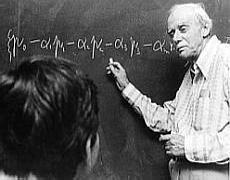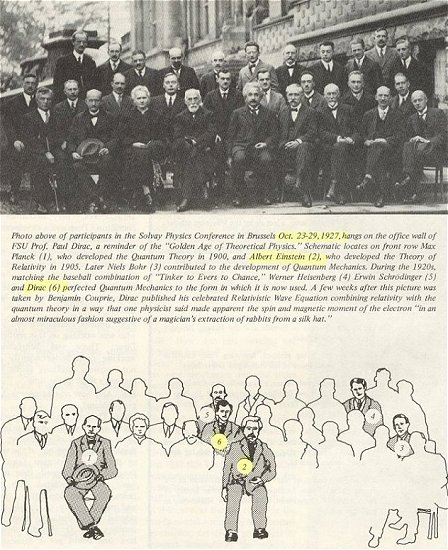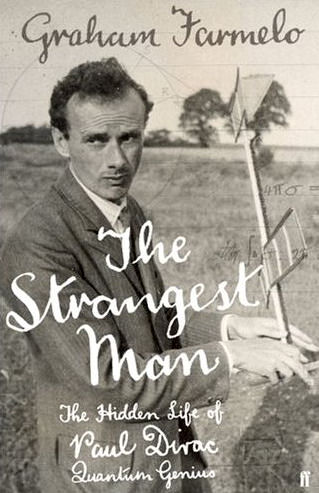|
|
|
|
|
|
Genealogy - Familienforschung - Généalogie
Descendants of
Paul Dirac's grandfather Louis-François
Dirac ( 1810-1882)
Paul Dirac's ancestors up to his great-great-great-grandparents
Paul Dirac's parents, siblings and children
Paul Adrien Maurice Dirac - 1902 - 1984
Paul Dirac received the Nobel Prize in Physics in 1933 at the age of 31.
|
P.A.M. Dirac |

Paul Dirac in his 80's |

October 1927 at the Solvay Physics
Conference in Bruxelles -
group picture with Albert Einstein, Paul Dirac and Marie Curie
Oct 2013: Zachary S. from Alaska
pointed out a factual error in this newspaper article of 1927.
Erwin Schrödinger is not the no. 5 on the above picture, but the man on this
person's left (above Einstein). Thanks, Zachary.
|
1907 - Paul's parents and siblings:
|
ca. 1945 - Paul's wife and children:
Paul and his wife Margit née Wigner |
|
August 1, 1991 - Paul Dirac was
honored with a |
November 13, 1995 - day of the
inauguration of a |
 |
Graham
Farmelo's biography about
appeared in January 2009 and was/is a big success. It was translated into several languages.
|
Paul Dirac Anecdotes
| Suitably Efficient? English physicist and Cambridge University professor Paul Dirac was an avid mountain climber and occasionally ascended such well-known peaks as Mount Elbruz in the Caucasus. In preparation for such excursions, Dirac would often climb trees in the hills just outside Cambridge - wearing the same black suit in which he was invariably seen around the university campus.
Logic and precision Dirac on Dostoevski Dirac on ghost Odd number of places Clarity It's not a question |
Statement When Paul Dirac made a rare error in an equation on the blackboard during a lecture one day, a couragous student raised his hand: "Professor Dirac," he declared, "I do not understand equation 2." When Dirac continued writing, the student, assuming that he had not been heard, raised his hand again and repeated his remark. Again Dirac merely continued writing... "Professor Dirac," another student finally interjected, "that man is asking a question." "Oh?" Dirac replied. "I thought he was making a statement."
Optimal distance to look at a woman Dirac discovers purling Wigner's sister Dirac on poetry God used beautiful mathematics in creating the world. This result is too beautiful to be false; it is more important to have beauty in one's equations than to have them fit experiment. |
"Paul Dirac - My Father" - lecture of Paul Dirac's
daughter Monica at the
Dirac Centennial Celebration in Cambridge, Sept. 2002 :
https://www.damtp.cam.ac.uk/events/strings02/dirac.html
Paul Dirac on-line biographies:
http://www.nobel-winners.com/Physics/paul_adrien_maurice_dirac.html
http://en.wikipedia.org/wiki/Paul_Dirac
Interesting articles about Paul Dirac:
https://web.archive.org/web/20040803164657/http://physicsweb.org/article/world/13/3/2 by Antonino Zichichi, University of Bologna
https://web.archive.org/web/20040807071409/http://physicsweb.org/article/world/11/2/9/1
by Sir Michael Berry, University of Bristol
Physics + Dirac =
Poetry by Graham Farmelo
Dirac
Genealogy (entry page)
Famile Tree of Pierre-Louis Dirac
(1748-1799) and his wife Andréanne Favre
Family Tree of François Dirac (1782-1847) and his wife Catherine Pignat
(1785-1851)
Family Tree of Louis-François
Dirac ( 1810-1882) including Paul Dirac
Family Tree of François
Dirac ( 1817-1899) including the American branch of the family
Paul Dirac, prix
Nobel de Physique en 1933
Descendants of Paul
Dirac's grandfather Louis-François Dirac ( 1810-1882)
Paul Dirac's ancestors
up to his great-great-great-grandparents
Paul Dirac's parents,
siblings and children
Le Village Dirac près d'Angoulême (Charente)
et de Bordeaux
Philippe Dirac - document de 1745
Les armoiries de Dirac (coat of arms)
E-Mail:
Copyright © by Gisela Dirac
![]()